The Bone Morphogenetic Protein Market is estimated to be valued at USD 358.0 million in 2025 and is projected to reach USD 579.3 million by 2035, registering a compound annual growth rate (CAGR) of 4.9% over the forecast period.
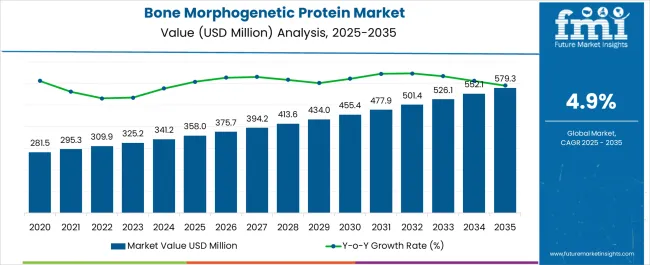
| Metric | Value |
|---|---|
| Bone Morphogenetic Protein Market Estimated Value in (2025 E) | USD 358.0 million |
| Bone Morphogenetic Protein Market Forecast Value in (2035 F) | USD 579.3 million |
| Forecast CAGR (2025 to 2035) | 4.9% |
The Bone Morphogenetic Protein market is experiencing robust growth, driven by the increasing prevalence of orthopedic conditions, spinal disorders, and bone injuries that require advanced regenerative solutions. The adoption of BMP-based therapies is being fueled by their ability to stimulate osteogenesis and enhance bone repair in complex fractures and spinal fusion procedures. Growth is further supported by technological advancements in recombinant protein production, formulation optimization, and delivery systems, which improve safety, efficacy, and patient outcomes.
Hospitals, specialty clinics, and surgical centers are increasingly implementing BMP-based products to address the limitations of conventional bone grafts, including donor site morbidity and graft availability. Rising awareness among healthcare providers and patients regarding minimally invasive and biologically active treatment options is further accelerating market adoption.
Regulatory approvals and clinical guideline endorsements for BMP usage in orthopedic and spinal procedures have strengthened market confidence As demand for bone repair and spinal fusion therapies continues to increase globally, the BMP market is expected to witness sustained growth, driven by technological innovation, improved patient outcomes, and broader clinical acceptance of recombinant BMP products.
The bone morphogenetic protein market is segmented by type, application, and geographic regions. By type, bone morphogenetic protein market is divided into RhBMP-2 and RhBMP-7. In terms of application, bone morphogenetic protein market is classified into Spinal Fusion, Trauma, Reconstruction, and Oral Maxillofacial. Regionally, the bone morphogenetic protein industry is classified into North America, Latin America, Western Europe, Eastern Europe, Balkan & Baltic Countries, Russia & Belarus, Central Asia, East Asia, South Asia & Pacific, and the Middle East & Africa.
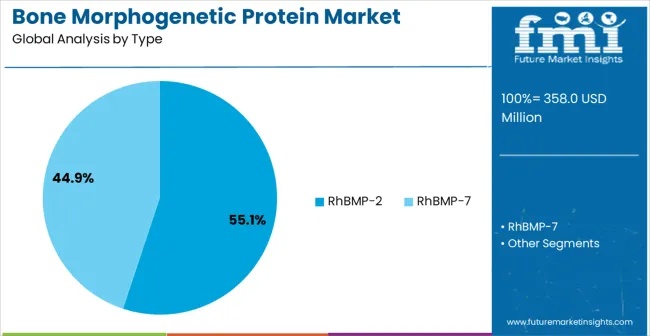
The RhBMP-2 type segment is projected to hold 55.1% of the market revenue in 2025, making it the leading BMP type. Its dominance is driven by its well-documented efficacy in promoting bone growth and facilitating spinal and orthopedic fusion procedures. RhBMP-2 has been extensively studied and validated in clinical trials, which has enhanced confidence among surgeons and healthcare institutions.
Its ability to reduce the need for autologous bone grafts and associated surgical complications has strengthened preference for this type. Delivery systems that enable controlled release and localized osteoinduction improve procedural outcomes and patient recovery.
Widespread availability and support from key healthcare providers further drive adoption As demand for safe, efficient, and predictable bone regeneration solutions continues to rise, RhBMP-2 is expected to maintain its leadership, supported by ongoing clinical research, technological improvements in delivery systems, and growing acceptance in complex orthopedic and spinal surgeries.
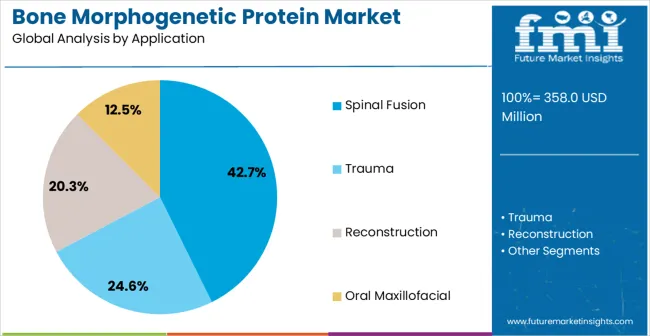
The spinal fusion application segment is expected to account for 42.7% of the market revenue in 2025, establishing it as the leading application area. Growth in this segment is being driven by the rising prevalence of spinal disorders, degenerative diseases, and traumatic injuries requiring fusion procedures. BMP-based products are increasingly preferred in spinal fusion surgeries due to their ability to promote osteogenesis, improve fusion rates, and reduce dependence on autologous bone grafts.
Advances in minimally invasive surgical techniques combined with BMP application enhance procedural outcomes, reduce patient recovery time, and minimize complications. Hospitals and specialized clinics are adopting BMP solutions to meet the growing demand for effective spinal therapies.
Regulatory approvals and evidence-based clinical guidelines supporting BMP use in spinal fusion further accelerate adoption As the global incidence of spinal disorders increases and healthcare providers prioritize enhanced patient outcomes, spinal fusion is expected to remain the primary driver of the Bone Morphogenetic Protein market, reinforced by continuous innovation in biologically active bone regeneration solutions.
Bone morphogenetic protein (BMPs) is the group of growth factors that belong to beta super family (TGF beta). These proteins are naturally occurring proteins. The family of this protein is involved in various cellular responses. Certain bone morphogenetic protein are said to induce the formation of bones and cartilage that is they are osteoinductive.
Many types of bone morphogenetic proteins are discovered, however only BMP 2, 4, 6, 7 and 9 are said to play a significant role in bone formation. Recombinant bone morphogenetic protein mainly, rh BMP-2 and rh-BMP-7 are used in orthopedic applications such as spinal fusions and oral surgery.
These recombinant proteins are approved for the mentioned application. It is believed that recombinant morphogenetic protein known as rh-BMP-7 can be used in certain kidney diseases.
The bone morphogenetic protein has proved to be useful for the patient undergoing spinal infusion treatment because of the elimination of pain. This advanced approach reduces the amount of pain, reduces the dependence on screw and spinal rods and has increased the rate of spinal fusion, which has will lead to increase in the global bone morphogenetic protein market through 2025.
Additionally, increase in number of accidents, spinal and bone injuries, rise in number of sports injuries, secondary lifestyle such as bad postures, increases in geriatric population are the major factors that are likely to propel the growth of the global bone morphogenetic protein market during the forecast period.
However, the increase in cost of the bone morphogenetic protein product, strict regulations issues, biocompatibility factor involved during the transplantation and the availability of the well established alternative bone grafts are few of the factors that can restrain the growth of the global bone morphogenetic protein market during the forecast period.
The global bone morphogenetic market is segmented into types of recombinant protein, application types and geography.
On the basis of the type of recombinant protein the global market is segmented into rh-BMP-2, rh- BMP-7 and others. rh- BMP-2 segment dominates the global market due to large acceptance of the protein by the physicians and surgeons globally, rise in number of sports injuries, favorable reimbursement policies etc. rh-BMP-7 is expected to diminish from the global market in future.
On the basis of application the global market is divided into spinal fusion, trauma, oral surgery, maxilla-facial defects and others. The spinal fusion segment holds the largest share in the global market owing to the factors like rise in spinal injuries, rise in geriatric population, rise in sports injuries etc.
Geographically, the global bone morphogenetic protein market is divided into North America, Western Europe, Eastern Europe, Latin America, Asia Pacific excluding Japan, Japan, Middle East and Africa. North America region is expected to dominate the global bone morphogenetic protein market through 2025 followed by Europe.
Rise in prevalence of spinal injuries, prevalence of unhealthy lifestyle, awareness of protein product, and rise in geriatric population. Asia Pacific region is expected to register a higher growth in the global bone morphogenetic protein market due to awareness among the people about bone morphogenetic protein, rise in number of accidents, developing research and technology, rise in healthcare spending capacity, rise in medical tourism in countries such as China and India etc.
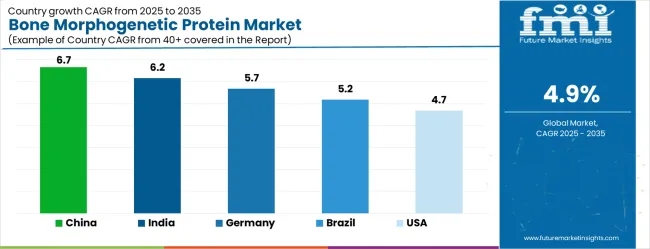
| Country | CAGR |
|---|---|
| China | 6.7% |
| India | 6.2% |
| Germany | 5.7% |
| Brazil | 5.2% |
| USA | 4.7% |
| UK | 4.2% |
| Japan | 3.7% |
The Bone Morphogenetic Protein Market is expected to register a CAGR of 4.9% during the forecast period, exhibiting varied country level momentum. China leads with the highest CAGR of 6.7%, followed by India at 6.2%. Developed markets such as Germany, France, and the UK continue to expand steadily, while the USA is likely to grow at consistent rates. Japan posts the lowest CAGR at 3.7%, yet still underscores a broadly positive trajectory for the global Bone Morphogenetic Protein Market. In 2024, Germany held a dominant revenue in the Western Europe market and is expected to grow with a CAGR of 5.7%. The USA Bone Morphogenetic Protein Market is estimated to be valued at USD 124.1 million in 2025 and is anticipated to reach a valuation of USD 124.1 million by 2035. Sales are projected to rise at a CAGR of 0.0% over the forecast period between 2025 and 2035. While Japan and South Korea markets are estimated to be valued at USD 18.6 million and USD 10.7 million respectively in 2025.
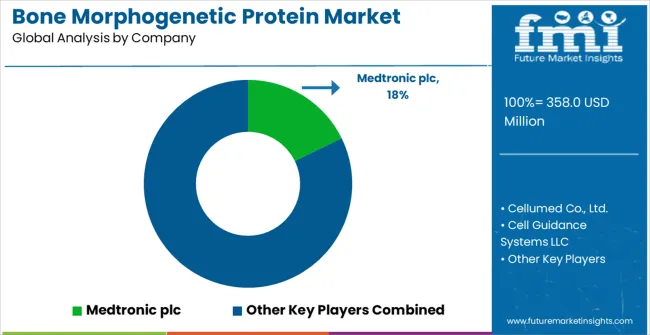
| Item | Value |
|---|---|
| Quantitative Units | USD 358.0 Million |
| Type | RhBMP-2 and RhBMP-7 |
| Application | Spinal Fusion, Trauma, Reconstruction, and Oral Maxillofacial |
| Regions Covered | North America, Europe, Asia-Pacific, Latin America, Middle East & Africa |
| Country Covered | United States, Canada, Germany, France, United Kingdom, China, Japan, India, Brazil, South Africa |
| Key Companies Profiled | Medtronic plc, Cellumed Co., Ltd., Cell Guidance Systems LLC, Merck KGaA, Prospec-Tany Technogene Ltd., Qkine Ltd., Bio-Techne., Thermo Fisher Scientific Inc., Proteintech Group, Inc., and STEMCELL Technologies |
The global bone morphogenetic protein market is estimated to be valued at USD 358.0 million in 2025.
The market size for the bone morphogenetic protein market is projected to reach USD 579.3 million by 2035.
The bone morphogenetic protein market is expected to grow at a 4.9% CAGR between 2025 and 2035.
The key product types in bone morphogenetic protein market are rhbmp-2 and rhbmp-7.
In terms of application, spinal fusion segment to command 42.7% share in the bone morphogenetic protein market in 2025.






Our Research Products

The "Full Research Suite" delivers actionable market intel, deep dives on markets or technologies, so clients act faster, cut risk, and unlock growth.

The Leaderboard benchmarks and ranks top vendors, classifying them as Established Leaders, Leading Challengers, or Disruptors & Challengers.

Locates where complements amplify value and substitutes erode it, forecasting net impact by horizon

We deliver granular, decision-grade intel: market sizing, 5-year forecasts, pricing, adoption, usage, revenue, and operational KPIs—plus competitor tracking, regulation, and value chains—across 60 countries broadly.

Spot the shifts before they hit your P&L. We track inflection points, adoption curves, pricing moves, and ecosystem plays to show where demand is heading, why it is changing, and what to do next across high-growth markets and disruptive tech

Real-time reads of user behavior. We track shifting priorities, perceptions of today’s and next-gen services, and provider experience, then pace how fast tech moves from trial to adoption, blending buyer, consumer, and channel inputs with social signals (#WhySwitch, #UX).

Partner with our analyst team to build a custom report designed around your business priorities. From analysing market trends to assessing competitors or crafting bespoke datasets, we tailor insights to your needs.
Supplier Intelligence
Discovery & Profiling
Capacity & Footprint
Performance & Risk
Compliance & Governance
Commercial Readiness
Who Supplies Whom
Scorecards & Shortlists
Playbooks & Docs
Category Intelligence
Definition & Scope
Demand & Use Cases
Cost Drivers
Market Structure
Supply Chain Map
Trade & Policy
Operating Norms
Deliverables
Buyer Intelligence
Account Basics
Spend & Scope
Procurement Model
Vendor Requirements
Terms & Policies
Entry Strategy
Pain Points & Triggers
Outputs
Pricing Analysis
Benchmarks
Trends
Should-Cost
Indexation
Landed Cost
Commercial Terms
Deliverables
Brand Analysis
Positioning & Value Prop
Share & Presence
Customer Evidence
Go-to-Market
Digital & Reputation
Compliance & Trust
KPIs & Gaps
Outputs
Full Research Suite comprises of:
Market outlook & trends analysis
Interviews & case studies
Strategic recommendations
Vendor profiles & capabilities analysis
5-year forecasts
8 regions and 60+ country-level data splits
Market segment data splits
12 months of continuous data updates
DELIVERED AS:
PDF EXCEL ONLINE
Bone Defect Repair Materials Market Size and Share Forecast Outlook 2025 to 2035
Protein-Coating Line Market Forecast Outlook 2025 to 2035
Bone Metabolism Test Market Size and Share Forecast Outlook 2025 to 2035
Protein Labelling Market Size and Share Forecast Outlook 2025 to 2035
Bone Health Supplement Market Size and Share Forecast Outlook 2025 to 2035
Protein Puddings Market Size and Share Forecast Outlook 2025 to 2035
Bone Densitometer Devices Market Size and Share Forecast Outlook 2025 to 2035
Protein/Antibody Engineering Market Size and Share Forecast Outlook 2025 to 2035
Protein Expression Market Size and Share Forecast Outlook 2025 to 2035
Bone and Teeth Supplements Market Size and Share Forecast Outlook 2025 to 2035
Protein Purification Resin Market Size and Share Forecast Outlook 2025 to 2035
Protein Hydrolysate For Animal Feed Application Market Size and Share Forecast Outlook 2025 to 2035
Protein Crisps Market Outlook - Growth, Demand & Forecast 2025 to 2035
Protein Hydrolysate Market Size and Share Forecast Outlook 2025 to 2035
Protein Supplement Market - Size, Share, and Forecast 2025 to 2035
Protein Powder Market Analysis - Size, Share, and Forecast Outlook 2025 to 2035
Protein Purification and Isolation Market Insights – Size, Share & Forecast 2025 to 2035
Protein Ingredients Market Analysis - Size, Share, and Forecast 2025 to 2035
Bone Densitometers Analysis by Product Type, by Technology and by End User through 2035
Protein A Resins Market Trends, Demand & Forecast 2025 to 2035

Thank you!
You will receive an email from our Business Development Manager. Please be sure to check your SPAM/JUNK folder too.
Chat With
MaRIA